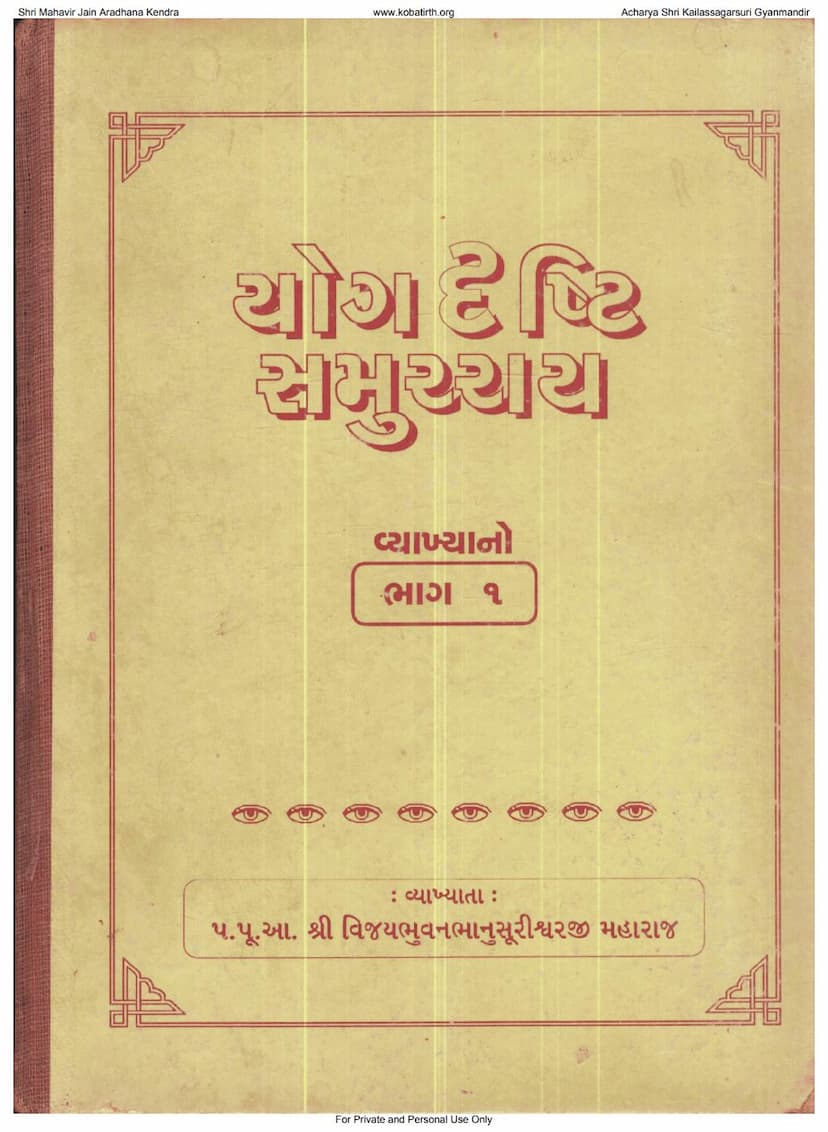Yogdrushti Samucchay Part 01
Added to library: September 2, 2025

Summary
This is a comprehensive summary of the provided Jain text, "Yogdrushti Samucchay Part 01," based on the content of the pages you shared:
Book Title: Yogdrushti Samucchay (Explanation of Lectures) Part 1 Original Author: Acharya Shri Haribhadrasurishvarji Maharaj Lecturer/Commentator: Acharya Shri Vijay Bhuvanbhanusurishvarji Maharaj Publisher: Divyadarshan Trust Catalog Link: https://jainqq.org/explore/020952/1
Overall Summary:
The text is the first volume of lectures delivered by Acharya Vijay Bhuvanbhanusurishvarji Maharaj, providing commentary and explanation on the profound Jain scripture "Yogdrushti Samucchay" authored by the venerable Acharya Haribhadrasurishvarji Maharaj. This volume, compiled by Muni Shri Kalparatnavijayji Maharaj and edited by Punyasthapati Shri Pasenavijayji Ganivar, aims to elucidate the deep philosophical concepts within the original text for the benefit of Jain followers.
Key Themes and Content Breakdown:
The initial pages introduce the book, its authors, and publishers. The following pages contain detailed introductory and review sections, primarily authored by Muni Shri Jayasundarvijayji Maharaj. These sections lay the groundwork for understanding the significance of "Yog" in Jainism and the unique contribution of Acharya Bhuvanbhanusurishvarji's commentary.
1. Significance of "Yog" in Jainism:
- The text emphasizes that the term "Yog" in Jain scriptures, while sometimes understood as the restraint of mental activities (similar to Patanjali Yoga), has a far broader meaning in Jainism.
- It encompasses all actions and practices that lead to the soul's liberation, from the initial stages of spiritual development up to the highest states of being.
- Jainism defines "Sanyogi" as a soul progressing up to the 13th stage of spiritual development and "Ayogi" as the soul in its liberated state (14th stage).
- The ultimate goal in Jainism is not "Yog" itself but the state of "A-Yog" or "Tattvakaaya Avastha" (state of being one with the elements or pure soul), which is achieved through the restraint of inauspicious activities (mind, speech, and body) and the propagation of auspicious activities.
2. Acharya Haribhadrasuriji's "Yogdrushti Samucchay":
- Acharya Haribhadrasuriji Maharaj is lauded as a scholar and philosopher who meticulously presented Jain teachings through his various works, including the "Yogdrushti Samucchay."
- He is credited with elaborating on the concept of "Yog" through various lenses, including the five aspects of Yoga (in "Yogbindu"), the five types of Yoga (in "Yogashatak"), and the eight perspectives of Yoga presented in "Yogdrushti Samucchay."
- The text highlights that Haribhadrasuriji's approach integrates logic and draws parallels with other philosophical schools while firmly grounding his explanations in Jain principles.
3. Acharya Bhuvanbhanusurishvarji's Commentary:
- The lectures presented in this volume are praised for their insightful and profound interpretations of Haribhadrasuriji's complex work.
- Acharya Bhuvanbhanusurishvarji is described as a master of various philosophical systems, who skillfully explains the intricate concepts of the "Yogdrushti Samucchay."
- The commentary aims to shed light on the hidden meanings and profound truths within the scripture, making them accessible to scholars and seekers.
- The reviewer highlights specific sections of the commentary that clarify difficult concepts like "Dharmakaya," "Karmakaya," "Tattvakaaya," the nature of "Bhavyatva" (potential for liberation), and the distinctiveness of Jain philosophy.
4. Emphasis on the Practical Application of Knowledge:
- A significant portion of the introductory material emphasizes the importance of not just theoretical knowledge but also the practical application of spiritual insights in daily life.
- The text critiques those who develop rigid opinions based on isolated scriptural passages without considering the broader context and diverse perspectives (Nayas) within Jainism.
- The lectures aim to provide a balanced view, reconciling seemingly contradictory statements by considering the relative nature of different Nayas, thereby fostering genuine understanding and intellectual rigor.
5. The Role of the Translator and Editor:
- The text acknowledges the significant contribution of Muni Shri Kalparatnavijayji Maharaj for transcribing the lectures and Muni Shri Jayasundarvijayji Maharaj for providing the review and introduction.
- The publication of the second edition was made possible through the generous support of the Chopati Jain Sangh and Shri Kalyan Parshwanath Jain Derasar Upashraya, Mumbai.
6. Addressing Controversies:
- The publisher's note implicitly addresses and refutes any "misunderstanding" or "unnecessary controversy" surrounding the Acharya's lectures, asserting their scriptural authenticity and grounding.
In essence, the first volume of "Yogdrushti Samucchay" serves as an in-depth exposition of the foundational principles of Yog in Jainism, as interpreted by Acharya Bhuvanbhanusurishvarji, aiming to guide spiritual aspirants towards a deeper understanding and practical application of these teachings.